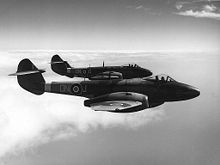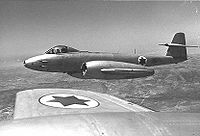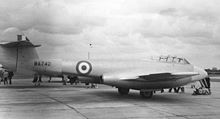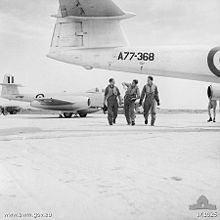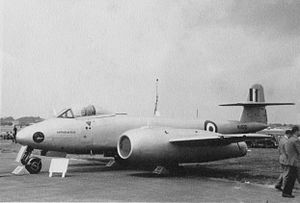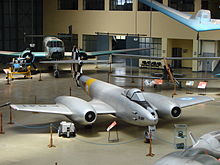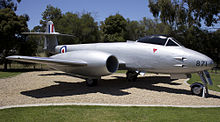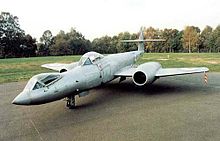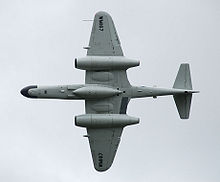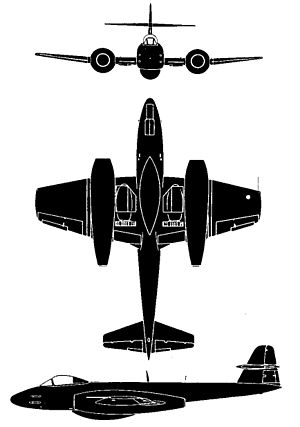- Gloster Meteor
-
Meteor Operational RAF Meteor F.4 in July 1955 Role Fighter Manufacturer Gloster Aircraft Company First flight 5 March 1943 Introduction 27 July 1944 Retired 1980s (RAF target tugs/Ecuador combat roles) Primary users Royal Air Force
Royal Australian Air Force
Belgian Air Force
Israeli Air ForceNumber built 3,947 The Gloster Meteor was the first British jet fighter and the Allies' first operational jet. It first flew in 1943 and commenced operations on 27 July 1944 with 616 Squadron of the Royal Air Force (RAF). The Gloster Meteor was not an aerodynamically advanced aircraft but the Gloster design team succeeded in producing an effective jet fighter that served the RAF and other air forces for decades. Meteors saw action with the Royal Australian Air Force (RAAF) in the Korean War, and remained in service with numerous air forces until the 1970s. Two Meteors, WL419 and WA638, remain in service with the Martin-Baker company as ejection seat testbeds.
Contents
Design and development
Development of a turbojet-powered fighter by Sir Frank Whittle's firm, Power Jets Ltd., and the Gloster Aircraft Company began in 1940, with George Carter, Gloster's chief designer, presenting initial proposals for a twin-engined jet fighter with a nosewheel undercarriage in August 1940. Gloster received an order for twelve prototypes (later reduced to eight) under Specification F9/40 on 7 February 1941.[1] The first British jet-powered aircraft, the single-engined Gloster E28/39 prototype, had its maiden flight on 15 May 1941.[2] A letter of intent for production of 300 of the new fighter, to be named Thunderbolt, was placed on 21 June but to avoid confusion with the USAAF P-47 Thunderbolt, the name was changed to Meteor.[3][4]
The Meteor's construction was all-metal with a tricycle undercarriage and conventional low, straight wings, featuring turbojets mid-mounted in the wings with a high-mounted tailplane to keep it clear of the jet exhaust.
Eight prototypes were produced. Delays with getting type approval for the engines meant that although taxiing trials were carried out it was not until the following year (1942) that flights took place. The fifth prototype, serial DG206, powered by two de Havilland Halford H.1 engines owing to problems with the intended Whittle W.2 engines, was the first to become airborne on 5 March 1943 from RAF Cranwell, piloted by Michael Daunt.[2] Development then moved to Newmarket Heath and, later, a Gloster-owned site at Moreton Valence. The first Whittle-engined aircraft, DG205/G, flew on 12 June 1943 (it crashed shortly after takeoff on 27 April 1944) and was followed by DG202/G on 24 July. DG202/G was later used for deck-handling tests aboard aircraft carrier HMS Pretoria Castle.[5] DG203/G made its first flight on 9 November 1943 but was eventually relegated to a ground instructional role. DG204/G (powered by Metrovick F.2 engines) first flew on 13 November 1943 and crashed on 1 April 1944. DG208/G made its debut on 20 January 1944, by which time the majority of design problems had been overcome and a production design approved. DG209/G was used as an engine test-bed by Rolls-Royce, first flying on 18 April 1944, while DG207/G was intended to be the basis for the Meteor F.2 with de Havilland engines, not flying until 24 July 1945, by which time the Meteor 3 was in full production and the F.2 was cancelled.[6][7]
On 12 January 1944, the first Meteor F.1, serial EE210/G, took to the air from Moreton Valence. It was essentially identical to the F9/40 prototypes except for the addition of four nose-mounted 20 mm (.79 in) Hispano Mk V cannons and some changes to the canopy to improve all-round visibility. For the production Meteor F.1, the engine was switched to the Whittle W.2 design, by then taken over by Rolls-Royce. The W.2B/23C turbojet engines produced 1,700 lbf (7.58 kN) of thrust each, giving the aircraft a maximum speed of 417 mph (670 km/h) at 3,000 m and a range of 1,610 km. The Meteor Mk.I was 41 ft 3 in (12.58 m) long with a span of 43 ft 0 in (13.11 m), with an empty weight of 8,140 lb (3,823 kg) and a maximum takeoff weight of 13,795 lb (6,270 kg).[8] This aircraft was later sent to the U.S., where it was first flown at Muroc Army Airfield on 15 April 1944.[9]
Typical of early jet aircraft, the Meteor F.1 suffered from stability problems at high transonic speeds, experiencing large trim changes, high stick forces and self-sustained yaw instability (snaking) caused by airflow separation over the thick tail surfaces.[10]
Operational service
The first 20 aircraft were delivered to the Royal Air Force on 1 June 1944; one was also sent to the U.S. in exchange for a Bell YP-59A Airacomet for comparative evaluation.
No. 616 Squadron RAF was the first to receive operational Meteors, 14 of them. The squadron was based at RAF Culmhead, Somerset and had been previously equipped with the Spitfire VII. After a conversion course at Farnborough for the six leading pilots, the first aircraft was delivered to Culmhead on 12 July 1944.[2] The squadron now with seven Meteors moved on 21 July 1944 to RAF Manston on the east Kent coast and, within a week, 30 pilots were converted.
The Meteor was initially used to counter the V-1 flying bomb threat. 616 Squadron Meteors saw action for the first time on 27 July 1944, when three aircraft were active over Kent. These were the Meteor's (and the Royal Air Force's) first operational jet combat missions. After some problems, especially with jamming guns, the first two V1 "kills" were made on 4 August. By war's end, Meteors accounted for 14 flying bombs.
After the end of the V-1 threat, and the introduction of the ballistic V-2 rocket, the RAF was forbidden to fly Meteor F.1 on combat missions over German-held territory for fear of an aircraft being shot down and then salvaged by the Germans. In any case, the greatly improved F.3 was in prospect. No. 616 Squadron briefly moved to RAF Debden to allow USAAF bomber crews to gain experience in facing jet-engined foes before moving to Colerne, Wiltshire.
No. 616 Squadron exchanged its F.1s for the first Meteor F.3s on 18 December 1944. This was a substantial improvement over the earlier mark, although the basic design still had not reached its potential. Wind tunnel and flight tests demonstrated that the original short nacelles, which did not extend fore and aft of the wing, contributed heavily to compressibility buffeting at high speed. New, longer nacelles not only cured some of the compressibility problems but added 120 km/h (75 mph) at altitude, even without upgraded powerplants. The last batch of Meteor F.3s featured the longer nacelles while other F.3s were retrofitted in the field with the new nacelles. The F.3 also had the new Rolls-Royce Derwent engines, increased fuel capacity, and a new larger, more strongly raked bubble canopy.
On 20 January 1945, four Meteors were moved to Melsbroek in Belgium. In March, the entire squadron was moved to Gilze-Rijen and then in April, to Nijmegen. The Meteors flew armed reconnaissance and ground attack operations without encountering any German jet fighters. By late April, the squadron was based at Faßberg, Germany and suffered its first losses when two pilots collided in poor visibility. The war ended with the Meteors having destroyed 46 German aircraft through ground attack[citation needed] and having faced more problems through misidentification as the Me 262 by Allied aircraft and flak than from the Luftwaffe.[citation needed] To counter this, continental-based Meteors were given an all-white finish as a recognition aid.
The next major change was the Meteor F.4 that went into production in 1946, by which time there were 16 RAF squadrons equipped with Meteors. The first F.4 prototype flew on 17 May 1945. The F.4 had the Rolls-Royce Derwent 5 engines (a smaller version of the famous Nene), wings 86.4 cm shorter than the F.3's and with blunter tips (derived from the world speed record prototypes), a stronger airframe, fully pressurized cockpit, lighter ailerons (to improve maneuverability), and rudder trim adjustments to reduce snaking. The F.4 could also be fitted with a drop tank under each wing while experiments were performed with carriage of underwing stores and also in lengthened fuselage models. The F.4 was 170 mph (270 km/h) faster than the F.1 at sea level (585 against 415), although the reduced wings impaired its rate of climb.
Because of the increased demand, F.4 production was divided between Gloster and the Armstrong Whitworth factory at Baginton. The majority of early F.4s did not go directly to the RAF: 100 were exported to Argentina (and saw action on both sides in the 1955 revolution, one being lost on 19 September 1955[11]) while in 1947, only RAF Nos. 74 and 222 Squadrons were fully equipped with the F.4. Nine further RAF squadrons were upgraded over 1948. From 1948, 38 F.4s were exported to the Dutch, equipping four squadrons (322, 323, 326 and 327) split between bases in Soesterberg and Leeuwarden until the mid-1950s. In 1949, only two RAF squadrons were converted to the F.4, Belgium was sold 48 aircraft in the same year (going to 349 and 350 Squadrons at Beauvechain) and Denmark received 20 over 1949–50. In 1950, three more RAF squadrons were upgraded, including No. 616 and, in 1951, six more. In 1950, a single order of 20 F.4s was delivered to Egypt.
A modified two-seater F.4 for jet-conversion and advanced training was tested in 1949 as the T.7. It was accepted by the RAF and the Fleet Air Arm and became a common addition to the various export packages (for example 43 to Belgium 1948–57, a similar number to the Netherlands over the same period, two to Syria in 1952, six to Israel in 1953, etc.). Despite its limitations—unpressurized cockpit, no armament, limited instructor instrumentation—over 650 T.7s were manufactured.
As improved jet fighters began to emerge, Gloster decided to perform a redesign of the F.4 to keep it up to date, while retaining as much of the manufacturing tooling of the F.4 as possible. The result was the Meteor F.8 (G-41-K) which was to be the definitive production model, serving as a major Royal Air Force single-seat fighter until the introduction of the Hawker Hunter and the Supermarine Swift.
The first prototype F.8 was a modified F.4, followed by a true prototype, VT150, that flew on 12 October 1948 at Moreton Valence.[12] Flight testing of the F.8 prototype led to the discovery of an aerodynamic problem: when ammunition was expended, the aircraft became tail-heavy and unstable around the pitch axis due to the weight of fuel retained in fuselage tanks no longer being balanced by the ammunition. Gloster designers solved the problem by substituting the tail of the abortive "G 42" single-engine jet fighter. The F.8 and other production variants were to successfully use the new tail design; the new tail gave the later Meteors a distinctive appearance, with taller straighter edges compared to the rounded tail of the F.4s and earlier marks.
The F.8 also featured a fuselage stretch of 76 centimetres (30 inches), intended to shift the aircraft's centre of gravity and also eliminate the use of ballast that had been necessary in earlier marks. The F.8 incorporated uprated engines, Derwent 8s, with 16 kN (1,633 kgp / 3,600 lbf) thrust each combined with structural strengthening, a Martin Baker ejection seat and a "blown" teardrop cockpit canopy that provided improved pilot visibility. Between 1950 and 1955, the Meteor F.8 was the mainstay of RAF Fighter Command, and served with distinction in combat in Korea with the RAAF as well as operating with many air forces worldwide, although it was clear that the original design was obsolete compared to contemporary swept-wing fighters such as the North American F-86 Sabre and the Soviet MiG-15.
Initial deliveries of the F.8 to the RAF were in August 1949, with the first squadron receiving its fighters in late 1950. Like the F.4, there were strong export sales of the F.8. Belgium ordered 240 aircraft, the majority assembled in The Netherlands by Fokker. The Netherlands had 160 F.8s, equipping seven squadrons until 1955. Denmark had 20, ordered in 1951; they were to be the last F.8s in front-line service in Europe. The RAAF ordered 94 F.8s, which served in Korea (see below). Despite arms embargoes, both Syria and Egypt received F.8s from 1952, as did Israel (where they served until 1961). On 1 September 1955, two Israeli F.8s shot down two Egyptian Vampires and in the 1956 Suez Crisis, F.8s were employed by both Egypt and Israel in ground-attack roles. After the crisis, both Egypt and Syria disposed of their Meteors in favour of various MiG variants. Brazil ordered 60 new Meteor F.8s and 10 T.7 trainers in October 1952, paying with 15,000 tons of raw cotton.[13]
In the 1950s, Meteors also were developed into effective photo-reconnaissance, training and night fighter versions. The fighter-reconnaissance (FR) versions were the first to be built, replacing the ageing Spitfires and Mosquitos then in use. Two FR.5s were built on the F.4 body; one was used for nose section camera tests and the other broke up in midair while in testing over Moreton Valence. On 23 March 1950, the first FR.9 flew. Based on the F.8, it was 20 cm longer with a new nose incorporating a remote-control camera and window and was also fitted with additional external ventral and wing fuel tanks. Production of the FR.9 began in July. No. 208 Squadron, then based at Fayid, Egypt was the first to be upgraded followed by the 2nd Tactical Air Force in West Germany, No. 2 Squadron RAF at Bückeburg and No. 79 Squadron RAF at RAF Gutersloh flew the FR.9 from 1951 until 1956. In Aden, No. 8 Squadron RAF was given the FR.9 in November 1958 and used them until 1961.[14] Ecuador (12), Israel (7) and Syria (2) were the only foreign customers for the FR.9.[15]
In addition to the armed, low-altitude operation, tactical FR.9 variant, Gloster also developed the PR.10 for high-altitude missions. The first prototype flew on 29 March 1950 and was actually converted into the first production aircraft. Based on the F.4, it had the F.4-style tail and the longer wings of the earlier variant. All the cannons were removed and a single camera placed in the nose with two more in the rear fuselage; the canopy was also changed. The PR.10 was delivered to the RAF in December 1950 and were given to No. 2 and No. 541 Squadrons in Germany and No. 13 Squadron RAF in Cyprus. The PR.10 was rapidly phased out from 1956 with improving surface to air missile technology and newer, faster aircraft rendering it obsolete.
Night fighter
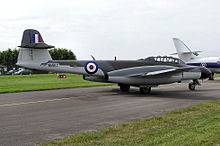 Privately owned Gloster Meteor NF.11 in 2005. Built by Armstrong Whitworth in 1952 at their Baginton (Coventry) factory.
Privately owned Gloster Meteor NF.11 in 2005. Built by Armstrong Whitworth in 1952 at their Baginton (Coventry) factory.
As a night fighter, the Meteor again replaced the Mosquito; however, it was never more than an interim measure. The Mosquito night fighter had remained in use even though it was largely obsolete. Gloster proposed a night fighter design to meet the Air Ministry specification for the Mosquito replacement. Based on the two seater trainer, the pilot in the front seat and the Navigator in the rear.[16] Once accepted however, the work passed to Armstrong Whitworth for both the detail design and production; the first prototype flew on 31 May 1950. Although based on the T.7 twin seater, it used the fuselage and tail of the F.8, and the longer wings of the F.3. An extended nose contained the AI Mk 10 (the 1940s Westinghouse SCR-720) Air Intercept radar. As a consequence the 20 mm cannons were moved into the wings, outboard of the engines. A ventral fuel tank and wing mounted drop tanks completed the Armstrong Whitworth Meteor NF.11.[17]
Nos. 29, 141 and 85 Squadrons were given the NF.11 in 1951 and the aircraft was rolled out across the RAF until the final deliveries in 1955. A "tropicalised" version of the NF.11 for Middle East service was developed; first flying on 23 December 1952 as the NF.13. The aircraft equipped No. 219 Squadron RAF at Kabrit and No. 39 Squadron at Fayid, both in Egypt. The aircraft served during the Suez crisis and remained with No. 39 Squadron when they were withdrawn to Malta until 1958. The aircraft had a number of problems, notably the limited visibility through the heavily framed T.7 canopy made landings tricky and the external fuel tanks under the wings tended to break up when the wing cannon were fired. Gun harmonisation, normally set to about 400 yards, was poor due to flexing of the wings in flight. Belgium (24), Denmark (20), Australia (one) and France (41) were the foreign customers for the NF.11. Ex-RAF NF.13s were sold to Syria (six), Egypt (six) and Israel (six). An Israeli NF.13 carried out Operation Tarnegol, downing an Egyptian Ilyushin Il-14 carrying high ranking members of the Egyptian Military on the eve of the Suez Crisis.[18] Some of the French aircraft remained in operation as test beds into the 1980s.
As radar technology developed, a new Meteor night-fighter was developed to use the improved US-built APS-21 system. The NF.12 first flew on 21 April 1953. It was similar to the NF 11 but had a nose section 17 inches (43.2 cm) longer;[19] the fin was enlarged to compensate for the greater keel area of the enlarged nose and to counter the airframe reaction to the "wig-wag" scan of the radar which affected the gunsighting, an anti-tramp motor operating on the rudder was fitted midway up the front leading edge of the fin. The NF.12 also had the new Rolls-Royce Derwent 9 engines and the wings were reinforced to handle the new engine.[20] Deliveries of the NF.12 started in 1953, with the type entering squadron service in early 1954,[21] equipping seven squadrons (Nos 85, 25, 152, 46, 72, 153 and 64);[22] the aircraft was replaced over 1958–59. Because of the "sensitive" nature of the radar system, no NF.12s were offered for export.
The final Meteor night fighter was the NF.14. First flown on 23 October 1953, the NF.14 was based on the NF.12 but had an even longer nose, extended by a further 17 inches to accommodate new equipment, increasing the total length to 51 ft 4 in (15.65 m) and a larger bubble canopy to replace the framed T.7 version.[23] Just 100 NF.14s were built; they first entered service in February 1954 beginning with No. 25 Squadron and were being replaced as early as 1956 with the Gloster Javelin. Overseas, they remained in service a little longer, serving with No. 60 Squadron at Tengah, Singapore until 1961. As the NF.14 was replaced, some 14 were converted to training aircraft as the NF(T).14 and given to No. 2 Air Navigation School on Thorney Island where they served until 1965.
Service during the Korean War
The Royal Australian Air Force acquired 113 Meteors between 1946 and 1952, 94 of which were the F.8 variant.[24] F.8 Meteors saw extensive service during the Korean War with No. 77 Squadron RAAF, part of British Commonwealth Forces Korea, and had personnel from other Commonwealth air forces attached to it. The squadron arrived in Korea equipped with P-51D Mustangs. It did jet conversion training at Iwakuni, Japan, and returned to Korea in April 1951 with about 30 Meteor F.8s and T.7s. The squadron moved to Kimpo in June, and was declared combat-ready the following month. There was some apprehension, as the F 8 was clearly inferior in most respects to the communist forces' MiG-15, and was superior to the North American F-86 Sabre only in rate-of-climb and acceleration.
No. 77 squadron first flew Meteors in a combat mission on 30 July 1951. The squadron had mainly been trained in the ground-attack role, and had difficulties when assigned to bomber escort duty at sub-optimum altitudes. On 29 August 1951, eight Meteors were on escort duty in "MiG Alley" when they were engaged by six MiG-15s; one Meteor was lost and two damaged, and 77 Squadron did not officially destroy any enemy aircraft on this occasion.[N 1] On 27 October, the squadron achieved its first probable followed by two probables six days later.[25] On 1 December, during a clash between 12 Meteors and some 40 MiG-15s, the squadron had its first two confirmed victories: Flying Officer Bruce Gogerly made the first kill. However, this occurred at the cost of four Meteors destroyed. As a result, bomber escort was taken over by the USAF and 77 Squadron returned to ground-attack duties. The Meteor performed well but proved vulnerable to ground fire, as the rocket sights required a long level run to operate effectively.
By the end of the conflict, the squadron had flown 4,836 missions, destroying six MiG-15s, over 3,500 structures and some 1,500 vehicles. About 30 Meteors were lost to enemy action in Korea—the vast majority shot down by anti-aircraft fire while serving in a ground-attack capacity.[24]
Record setting
Late in 1945, two F.3 Meteors were modified for an attempt on the world air speed record. On 7 November 1945 at Herne Bay in Kent, UK, Group Captain H.J. (Willy) Wilson set the first official air speed record by a jet aircraft of 606 mph (975 km/h) TAS.[26] A small plaque commemorating this achievement can be found in Macari's Cafe, Herne Bay.
In 1946, Group Captain Edward "Teddy" Donaldson broke this record with a speed of 616 mph (991 km/h) TAS, in EE549, a Meteor F.4.[27] Test pilot Roland Beamont had previously taken the same aircraft to its compressibility limit at 632 mph (1,017 km/h), but not under official record conditions, and outside its official safety limits.
In 1947, Sqn Ldr Janusz Żurakowski set an international speed record: London-Copenhagen-London, 4–5 April 1950 in a production standard F.8 (VZ468). The Danes were suitably impressed and purchased the type soon after.[28]
Another "claim to fame" was the Meteor's ability to perform the "Żurabatic Cartwheel", a new aerobatics manoeuvre, named after the Gloster acting Chief Test Pilot, first accomplished in the Gloster Meteor G-7-1 prototype at the 1951 Farnborough Air Show where the Meteor, due to its unique location of widely set engines could have individual engines throttled back and forward to achieve a seemingly stationary vertical cartwheel. Many Meteor pilots went on to "prove their mettle" by attempting the same feat.[29]
On 7 August 1949, the Meteor III, EE397, on-loan from the RAF and flown by Flight Refuelling Ltd (FRL) test pilot Patrick Hornidge, took off from Tarrant Rushton and, refuelled 10 times by the Lancaster tanker, remained airborne for 12 hours and 3 minutes, receiving 2,352 gallons of fuel from the tanker in ten tanker contacts and flying an overall distance of 3,600 miles (5,800 km), achieving a new jet endurance record.[30]
Meteor F.8 WA820 was adapted during 1948 to take two Armstrong Siddeley Sapphire turbojets, and from Moreton Valence, on August 31st, 1951, established a time-to-height climb record. The pilot was Flt Lt Tom Prickett, of Armstrong Siddeley. A height of 9,843 ft was reached in 1 min 16 sec, 19,685 ft in 1 min 50 sec, 29,500 ft in 2 min 29 sec, and 39,370 ft in 3 min 7 sec. Air Service Training Ltd were responsible for the conversion.[31]
Other uses
Production of the Meteor continued until 1954 with almost 3,900 made, mainly the F.8 variant. As the Meteor was progressively relegated to secondary duties in later years, target tug, drone and specialized test vehicles were added to the diverse roles that this first-generation jet fighter took on.
Safety record
A total of 890 Meteors were lost in service with the RAF (145 crashes in 1953 alone), resulting in the deaths of 450 pilots.
Contributory factors in the number of crashes were the high fuel consumption and therefore short endurance (less than one hour) causing pilots to run out of fuel, and difficult handling with one engine out due to the widely set engines. The casualty rate was exacerbated by the lack of ejection seats except in the F.8, especially in the training version T.7 and F.4 fighters relegated to training/conversion duties.[32] [N 2]
Variants
- Gloster F.9/40
- Prototypes, eight built -
- DG202/G powered by two Rover W2B jet engines, first flown 24 July 1943.
- DG203/G powered by two Power Jets W2/500 engines, first flown 9 November 1943.
- DG204/G powered by two Metrovik F2 jet engines, unlike the other F.9/40s the engines were mounted under the wing, first flown 13 November 1943.
- DG205/G powered by two Rover W2B/23 jet engines, first flown 12 June 1943.
- DG206/G powered by two Halford H1 jet engines, the first to fly on 5 March 1943.
- DG207/G powered by two Halford H1 jet engines, first flown 24 July 1945, became the prototype F.2 variant.
- DG208/G powered by two Rover W2B/23 engines, first flown 20 January 1944.
- DG209/G powered by two Rover W2B/27 engines, first flown 18 April 1944.
- Meteor F.1
- First production aircraft built between 1943 and 1944, 20 built.
- Meteor F.1, Trent turboprop
- One-off engine test bed, built 1945, designated EE227, for the new and highly successful Rolls-Royce Trent turboprop engine making it the world's first turboprop-powered aircraft.
- Meteor F.2
- Alternative engined version – only one built.
- Meteor F.3
- Derwent I powered with sliding canopy, first flown 11 September 1944, 210 built (first 15 were Welland-powered)
- Meteor F.4
- Derwent 5 powered with strengthened fuselage, 489 built by Glosters and 46 by Armstrong Whitworth for the Royal Air Force. The F.4 was also exported to Argentina (50 aircraft), Belgium (48 aircraft), Denmark (20 aircraft), Egypt (12 aircraft), Netherlands (38 aircraft).
- Meteor FR.5
- One-off fighter reconnaissance version of the F.4, fitted with vertical cameras in the nose instead of the four cannon and had obliques cameras in the fuselage, destroyed on maiden flight 15 June 1949.
- Meteor F.6
- Proposed swept-wing variant of the F.4, not built.
- Meteor T.7
- Two-seat trainer variant of the F.4, company prototype first flew 19 March 1948, 640 production aircraft for the Royal Air Force and the Royal Navy (43) and 72 for export (Belgium, Brazil, Denmark, Egypt, France, Israel, Netherlands). Avions Fairey modified 20 Belgian Air Force F.4s to T.7 standard.
- Meteor F.8
- Greatly improved from the F.4. Longer fuselage, greater fuel capacity, standard ejection seat and modified tail (derived from the E.1/44). This variant was a prolific frontline fighter in RAF squadron service, 1950–54.
- Meteor F.8 Prone Pilot
- One-off experimental prone pilot F.8, WK935 modified by Armstrong Whitworth.
- Meteor FR.9
- Fighter armed reconnaissance version of the F.8, first flown 23 March 1950, 126 built by Glosters for the Royal Air Force. Former RAF aircraft were later sold to Ecuador, Israel and Syria.
- Meteor PR.10
- Photo reconnaissance version of the F.8, first flown 29 March 1950, 59 built for the Royal Air Force.
- Meteor NF.11
- Night Fighter variant with Airborne Intercept radar designed and built by Armstrong Whitworth, three protoypes followed by 311 production aircraft for the Royal Air Force and 20 for the Royal Danish Air Force.
- Meteor NF.12
- Longer nosed version of the NF.11 with American AN/APS-21 radar, this was balanced by a slightly larger fin, first flown on 21 April 1953, 100 built by Armstrong Whitworth.
- Meteor NF.13
- Tropicalised version of the NF.11 to replace the Mosquito NF.36 for service with 39 Squadron in Malta and Cyprus and 219 Squadron based in Egypt. The first of 40 production aircraft built by Armstrong Whitworth was first flown on 21 December 1952. Former Royal Air Force aircraft were later sold to Egypt (6 aircraft), France (2 aircraft), Israel (6 aircraft) and Syria (6 aircraft).
- Meteor NF.14
- NF.11 with new two-piece blown canopy rather than the heavy-framed version. It also had a longer nose giving a length of 51 ft 4 in. Protoype modified from an NF.11 was first flown 23 October 1953 and was followed by 100 production aircraft built by Armstrong Whitworth for the Royal Air Force.
- Meteor U.15
- Target drone conversion of the F.4, 92 modified by Flight Refuelling.[33]
- Meteor U.16
- Target drone conversion of the F.8, 108 modified by Flight Refuelling.[33]
- Meteor TT.20
- High speed target towing conversion of the NF.11 for the Royal Navy by Armstrong Whitworth, 20 former Royal Air Force NF.11s were modified. Four additional conversions of four NF.11s of Royal Danish Air Force, after conversion these were flown by civil operators on behalf of the Danish military.[34]
- Meteor U.21
- Target drone conversion of the F.8 for the Royal Australian Air Force by Flight Refuelling, some aircraft modified in Australia by Fairey Aviation of Australasia using Flight Refueling supplied modification kits.[33]
- Ground Attack Fighter
- Also known as the Reaper, it was a F.8 modified by Gloster as a private venture ground attack fighter. The modification allowed the carriage of external Rocket-Assisted Take-Off Gear (RATOG), added a ventral cannon and tip tanks. First flown 4 September 1950, only one was built.[35]
Operators
Military operators
- Argentine Air Force ordered 100 F.4s in May 1947, comprising 50 ex-RAF aircraft and 50 newly built.[36] Deliveries started in July that year,[37] the Meteor remaining in service until 1970, when the last examples were replaced by Dassault Mirage IIIs.[38]
- Royal Australian Air Force operated 104 aircraft from 1946 to 1947 and 1951 to 1963.
- Belgian Air Force received 40 aircraft of F.4 variant, 43 of T.7 variant, 240 of F.8 variant and 24 aircraft of NF.11 variant.
- Biafran Air Force purchased two Meteor NF 14s through a cover company. One crashed during a ferry flight between Madeira and Cape Verde, while the second was abandoned at Bissau, Portuguese Guinea.[39] An attempt to purchase a further two ex-Danish target tugs via a German intermediary was discovered by the Bundesnachrichtendienst, the West German intelligence service, and stopped by grounding the aircraft.[40]
- Brazilian Air Force received 62 aircraft in F.8 and TF.7 variants.
- 2°/1°GAvCa
- 1°/1°GAvCa
- 1°/14°GAv
- Royal Canadian Air Force — from 1945 to 1950, one Meteor III and Meteor T.7 were used for tests and evaluation by the RCAF.
- Royal Egyptian Air Force
- Luftwaffe – Meteor TT.20 target towing aircraft.
- Royal New Zealand Air Force
- No. 14 Squadron RNZAF operated two Meteor T.7 aircraft hired from the RAF.
- South African Air Force – Meteor F.3 aircraft, in service from 1946 to 1949.
- Swedish Air Force operated Meteors by Svensk Flygtjanst under Air Force contract.
-
- 700 Naval Air Squadron
- 702 Naval Air Squadron
- 703 Naval Air Squadron
-
- 728 Naval Air Squadron
- 736 Naval Air Squadron
- 759 Naval Air Squadron
-
- 764 Naval Air Squadron
- 767 Naval Air Squadron
- 771 Naval Air Squadron
-
- 781 Naval Air Squadron
- 806 Naval Air Squadron
- 813 Naval Air Squadron
- United States Army Air Forces tested one aircraft and returned it to UK after tests.
Civilian operators
- DERA Llanbedr
- Martin-Baker Aircraft Company
- Flight Refuelling Ltd (FRL) were lent the RAF Meteor III EE397 for use in probe-and-drogue trials. This aircraft set a world jet endurance record of 12 hours and 3 minutes on 7 August 1949
Survivors
Main article: List of surviving Gloster MeteorsAlthough many Meteors survive in museums, collections and on pylons in public spaces, only five remain airworthy. Four of these are in the United Kingdom, two Meteor T.7/F.8 Hybrids used by Martin-Baker as ejector seat test aircraft "WA638" & "WL419", a privately owned former RAF NF.11 (G-LOSM) based at Coventry (where it was built) and a recently restored RAF T7 (WA591) also at Coventry. A former RAF F.8 flies in Australia with the Temora Aviation Museum with Royal Australian Air Force markings as 'A77-851'
Specifications (Meteor F.8)
Data from The Great Book of Fighters[44] and Quest for Performance[10]
General characteristics
- Crew: 1
- Length: 44 ft 7 in (13.59 m)
- Wingspan: 37 ft 2 in (11.32 m)
- Height: 13 ft 0 in (3.96 m)
- Wing area: 350 ft² (32.52 m²)
- Empty weight: 10,684 lb (4,846 kg)
- Loaded weight: 15,700 lb (7,121 kg)
- Powerplant: 2 × Rolls-Royce Derwent 8 turbojets, 3,500 lbf (15.6 kN) each
Performance
- Maximum speed: 600 mph (522 knots, 965 km/h, Mach 0.82) at 10,000 ft (3,050 m)
- Range: 600 mi (522 nmi, 965 km)
- Service ceiling: 43,000 ft (13,100 m)
- Rate of climb: 7,000 ft/min (35.6 m/s)
- Wing loading: 44.9 lb/ft² (149 kg/m²)
- Thrust/weight: 0.45
- Time to altitude: 5.0 min to 30,000 ft (9,145 m)
Armament
- Guns: 4 × 20 mm British Hispano cannons
- Rockets: Provision for up to sixteen "60lb" 3 in rockets or eight 5 in HVAR rockets. under outer wings
- Bombs: two 1.000 lb (454 kg)
See also
- Aircraft of comparable role, configuration and era
- Related lists
- List of World War II jet aircraft
References
- Notes
- ^ According to anecdotal accounts, Warrant Officer Ron Guthrie did destroy a MiG-15 in this engagement. He was shot down during the same dogfight and captured by communist ground forces. It has been reported that, during interrogation, two Soviet pilots, through an interpreter, told Guthrie that he had downed a MiG-15. He survived internment and was released on 3 September 1953.[citation needed]
- ^ "The Night It Rained Meteors" article is written by former RAF pilot and world helicopter aerobatic champion Dennis Kenyon.
- Citations
- ^ James 1971, pp. 245–248.
- ^ a b c Mason 1992, p. 339.
- ^ James 1971, p. 247.
- ^ Goulding 1986, p. 144.
- ^ James 1971, p. 249.
- ^ Goulding 1986, pp. 148–149.
- ^ James 1971, p. 358.
- ^ James 1971, pp. 304–305.
- ^ Berry, Peter. "The Whittle/Rover W2B and Rolls-Royce W2B/23 Welland Turbo-Jets." enginehistory.org. Retrieved: 30 January 2010.
- ^ a b Loftin, L.K. Jr. "Quest for Performance: The Evolution of Modern Aircraft, NASA SP-468." NASA. Retrieved: 24 April 2006.
- ^ Cicaleso, del Gaizo and Rivas 2003, pp. 69–72.
- ^ Mason 1992, p. 341.
- ^ James 1971, p. 369.
- ^ Harrison 2001, p. 31.
- ^ Harrison 2001, p. 28.
- ^ Williams Aeroplane Monthly April 1995, p. 6–7.
- ^ Williams 1984, pp. 45–46.
- ^ Yonay 1993, pp. 161–163.
- ^ Williams 1984, pp. 50–51.
- ^ James 1971, p. 297.
- ^ Williams Aeroplane Monthly June 1995, p. 14.
- ^ James 1971, p. 366.
- ^ Williams 1984, pp. 51–53.
- ^ a b "ADF Aircraft Serial Numbers: RAAF A77 Gloster Meteor F 8." adf-serials.com. Retrieved: 8 August 2010.
- ^ "RAAF Airpower." raaf.gov.au. Retrieved: 23 March 2010.
- ^ James 1971, pp. 257–258.
- ^ James 1971, pp. 258–259.
- ^ Zuk 2004, p. 145.
- ^ "Janusz Żurakowski 'Zura' 1914–2004, Biography of the World Famous Pilot." zurakowskiavroarrow.homestead.com. Retrieved: 23 March 2010.
- ^ Webster, David. "50 Years of Probe and Drogue Flight Refuelling cover signed Air Chief Marshal Sir Michael Knight KCB AFC FRAES, Director of Flight Refuelling Limited." the-best-of-british.com. Retrieved: 23 March 2010.
- ^ King, H. F., 1955, p. 729.
- ^ Kenyon, Dennis. "The Night It Rained Meteors".Loop aviation newspaper, June 2008.
- ^ a b c James 1987, pp. 300–302.
- ^ James 1987, pp. 302–303.
- ^ James 1987, pp. 283–286.
- ^ James 1971, p. 262.
- ^ Cicaleso, del Gaizo and Rivas 2003, p. 69.
- ^ Cicaleso, del Gaizo and Rivas 2003, p. 72.
- ^ Williams Aeroplane Monthly July 1995, p. 44.
- ^ Williams Aeroplane Monthly July 1995, pp. 46–47.
- ^ Jefford 2001, p. 175.
- ^ Caruana and Franks 2004, pp. 124–125.
- ^ Sturtivant, Ray and Theo Ballance. The Squadrons of the Fleet Air Arm. Tonbridge, Kent, UK: Air-Britain (Historians) Ltd, 1994. ISBN 0-85130-223-8.
- ^ Green 2001
- Bibliography
- Andrews, C.F. "The Gloster Meteor F.8" Aircraft in Profile, Volume 1/Part1. Windsor, Berkshire, UK: Profile Publications Ltd., 4th revised edition 1975 (first published in 1965). ISBN 0-85383-410-5.
- Ashley, Glenn. Meteor in Action. Carrollton, Texas: Squadron/Signal Publications Inc., 1995. ISBN 0-89747-332-9.
- Bowyer, Chaz. Postwar Military Aircraft 2: Gloster Meteor. Shepperton, Surrey, UK: Ian Allen Ltd., 1985. ISBN 0-7110-1477-9.
- Butler, Phil and Tony Buttler. Gloster Meteor: Britain's Celebrated First-Generation Jet. Hersham, Surrey, United Kingdom: Midland Publishing, 2007. ISBN 1-85780-230-6.
- Caruana, Richard J. and Richard A. Franks. The Gloster & AW Meteor. Kingsway, Bedford, United Kingdom: SAM Publications, 2004. ISBN 0-9533465-8-7.
- Cicalesi, Juan Carlos, César del Gaizo and Santiago Rivas. "Into the Jet Age: The Gloster Meteor in Argentina". Air Enthusiast No. 104, March/April 2003, pp. 68–73. Stamford, UK: Key Publishing. ISSN 0143-5450.
- Goulding, James. Interceptor: RAF Single Seat Multi-Gun Fighters. London: Ian Allen, 1986. ISBN 0-7110-1583-X.
- Green, William and Gordon Swanborough. The Great Book of Fighters. St. Paul, Minnesota: MBI Publishing, 2001. ISBN 0-7603-1194-3.
- Harrison, W.A. "Forgotten Breed... The RAF's Last 'Shufti' Meteors". Air Enthusiast, No 93, May/June 2001, pp. 26–33. Stamford, UK: Key Publishing. ISSN 0143 5450.
- James, Derek N. Gloster Aircraft since 1917. London: Putnam, 1971. ISBN 0-370-00084-6.
- Jefford, Wing Commander C.G., MBE,BA,RAF (Retd). RAF Squadrons, A Comprehensive Record of the Movement and Equipment of all RAF Squadrons and their Antecedents since 1912. Shrewsbury, Shropshire, UK: Airlife Publishing, 2001. ISBN 1-84037-141-2.
- Jones, Barry. Gloster Meteor. Ramsbury, Marlborough, Wiltshire, United Kingdom: The Crowood Press Ltd., 1998. ISBN 1-86126-162-4.
- King, H. F., M.B.E.. "Mars to Javelin, Gloster aircraft of forty years". Flight and Aircraft Engineer, May 1955, No. 2418 Vol. 67. p. 729.
- Loftin, L.K. Jr. Quest for Performance: The Evolution of Modern Aircraft. NASA SP-468. Retrieved: 22 April 2006.
- Mason, Francis K. The British Fighter Since 1912. Annapolis, Maryland: Naval Institute Press. 1992. ISBN 1-55750-082-7.
- Partridge, J.J. "The Gloster Meteor F.IV" Aircraft in Profile, Volume 4. Windsor, Berkshire, UK: Profile Publications Ltd., 2nd revised edition 1970 (original in 1966). ISBN 0-85383-013-4.
- Shacklady, Edward. The Gloster Meteor. London: Macdonald & Co. (Publishers) Ltd., 1962.
- Williams, Ray. "The Night-Fighting Meteor". Air Enthusiast, Twenty-five, August–November 1984, pp. 44–59. Bromley, Kent, UK: Fine Scroll. ISSN 0143-5450.
- Williams, Ray. "Meteor Night Fighters: Part One". Aeroplane Monthly, April 1995, Vol. 23, No 4, Issue No. 264, pp. 6–10.
- Williams, Ray. "Meteor Night Fighters: Part Two". Aeroplane Monthly, May 1995, Vol. 23, No 5, Issue No. 265, pp. 18–22.
- Williams, Ray. "Meteor Night Fighters: Part Three". Aeroplane Monthly, June 1995, Vol. 23, No 6, Issue No. 266, pp. 10–24.
- Williams, Ray. "Meteor Night Fighters: Part Four". Aeroplane Monthly, July 1995, Vol. 24 No 1, Issue No. 267, pp. 42–47.
- Yonay, Ehud. No Margin for Error: The Making of the Israeli Air Force. New York: Pantheon Books, 1993. ISBN 978-0679415633.
- Zuk, Bill. Janusz Zurakowski: Legends in the Sky. St. Catharine's, Ontario: Vanwell, 2004. ISBN 1-55125-083-7.
External links
- Preserving the Gloster aviation heritage
- Flight article of 1945 describing structure of Meteor
- Temora Aviation Museum Meteor F 8
- Meteor flight
- Warbird Alley: Meteor
- Imperial War Museum Duxford: Meteor F 8
- Jewish Virtual Library: Meteor
- Vic Flintham (aviation historian): Meteor
- Jets 35: Trent engine
- 2 Sqn Association Meteor album
- Archival RAF film from 1948 on fighter tactics around bomber formations, in collaboration with the USAAF.
- Progress with Jet Propulsion Flight 1945
Gloster aircraft Mars · I · Sparrowhawk · Mars VI Nighthawk · Mars X Nightjar • Gannet · Grebe · Grouse · Gorcock · II · III · Gamecock · Guan · Goral · Goring · IV · Goldfinch · Gambet · Gnatsnapper · VI · Gauntlet · AS.31 · TC.33 · TSR.38 · Gladiator · F.5/34 · F.9/37 · E.28/39 · Meteor · E.1/44 · Javelin · Meteor "Prone Pilot" · GA.1 · GA.2 · GA.3 · GA.4 · GA.5
Lists relating to aviation General Aircraft (manufacturers) · Aircraft engines (manufacturers) · Airlines (defunct) · Airports · Civil authorities · Museums · Registration prefixes · Rotorcraft (manufacturers) · TimelineMilitary Accidents/incidents Records Categories:- British fighter aircraft 1940–1949
- Gloster aircraft
- Military aircraft of the Korean War
- World War II jet aircraft of the United Kingdom
Wikimedia Foundation. 2010.


